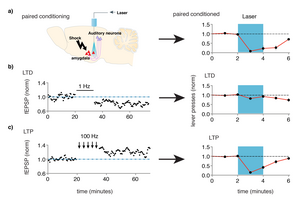Dr. Sadegh Nabavi did his PhD studies at the Department of Molecular Biology and Genetics at University of Guelph in Canada, and then postdoctoral research at the Center for Neural Circuits and Behavior, Department of Neurosciences, at the University of California in San Diego.
Dr. Sadegh Nabavi’s research focus is on understanding how plasticity at the synaptic and circuit levels relates to behavioral plasticity (learning and memory formation) and how the newly formed memories are integrated into the existing network (cellular and systems consolidation) using rodents as model organism.
Dr. Sadegh Nabavi’s research activities complement the expertise and research programmes of the other current research groups at DANDRITE, where the first two Group Leaders recruited at DANDRITE are focusing on embryonic and reprogrammed stem cells in Parkinson disease (Dr. Mark Denham) and the brain circuitries and behavior in Drosophila (Dr. Anne von Philipsborn), and the last two recruited group leaders are focusing on the structure, function and development of neural circuits in the visual system (Dr. Keisuke Yonehara) and the genetic and neuronal circuit mechanisms that underlie effort based decision-making in flies, rodents and humans (Dr. Duda Kvitsiani).
The DANDRITE core groups are focusing on structural biology of membrane transporters, receptors and biomembranes (Prof. Poul Nissen), sorting/trafficking, trans-synaptic communication and signaling in nerve cells as mediated by sortilin receptors and neurotrophic factors and studied in transgenic animal models (Prof. Anders Nykjær) and molecular cell biology of intracellular signaling networks with focus on Parkinson disease and dementia (Prof. Poul Henning Jensen).
Furthermore, the DANDRITE researchers engage in many collaborations at Aarhus University, Aarhus University Hospital, and the Danish neuroscience community.

The idea that changes in synaptic strength (synaptic plasticity) is the foundation of memory and learning has a long history. For this reason long term potentiation (LTP) and long term depression (LTD), the electrophysiological manifestations of synaptic plasticity, have been intensely studied. However, the proof of causality, that by changing synaptic strength one can remove and reinstate a memory, had been missing.
In our recent paper we provided the most direct evidence showing a cause-effect relation between synaptic plasticity and memory formation (Nabavi et al., 2014, Nature). With the use of optogenetics fortified by in vitro/in vivo recording and behavioral assays we generated an associative memory and showed that we could repeatedly turn off and on this associative memory simply by inducing LTD and LTP (see the figure).
An immediate question following this study is how these newly formed memories are integrated into the existing network. This is a vital concern for any system that aims to store and retrieve information. Our brain is continuously exposed to external sensory inputs. This amount of information can overwhelm any storage device no matter how large its capacity. Therefore, a challenge for our brain is to decide which information is worthy of permanent storage. The storage process itself, however, poses another challenge: how to integrate new information into a network of pre-existing memories without “catastrophic interference” (forgetting).
The first challenge is commonly known as synaptic consolidation, which takes place within the first minutes to hours after memory formation. The second challenge, known as systems consolidation, is a slower process that takes weeks, months or even years. The major focus of my research is to understand how our brain tackles these challenges. To this end we will use a combination of tools such as molecular biology, in vitro and in vivo electrophysiology, two-photon laser scanning microscopy, optogenetics, behavioral analysis (i.e. whatever it takes) to move forward.
These studies may lead us to better understand and treat better neuropsychological diseases thought to be related to aberrations in synaptic plasticity, such as posttraumatic stress disorder, schizophrenia, substance abuse disorders and dementia.
The Danish Research Institute of Translational Neuroscience – DANDRITE is the Danish node of the Nordic EMBL Partnership for Molecular Medicine and therefore adhere to the EMBL model for international recruitment.
DANDRITE is established with support from the Lundbeck Foundation at Aarhus University. The research scope is on molecular mechanisms underlying intra- and intercellular signaling networks that govern neuronal functionality and circuitry, how these mechanisms define behaviour and are altered in neurological and psychiatric disorders.
DANDRITE is embedded in the vibrant NeuroCampus research community at Aarhus University and Aarhus University Hospital and encompasses genetics, molecular and clinical medicine, bioimaging, cell and animal modeling, structural biology and nanoscience, and with long-standing traditions in membrane proteins and neuroscience.
DANDRITE Group Leader Sadegh Nabavi, snabavi@dandrite.au.dk
DANDRITE Director and Core Group Leader Prof. Poul Nissen, pn@mbg.au.dk
DANDRITE Core Group Leader Poul Henning Jensen, phj@biomed.au.dk
DANDRITE Core Group Leader Anders Nykjær, an@biomed.au.dk
DANDRITE Administrative Officer Else Magård, ema@dandrite.au.dk